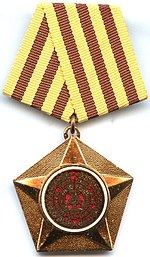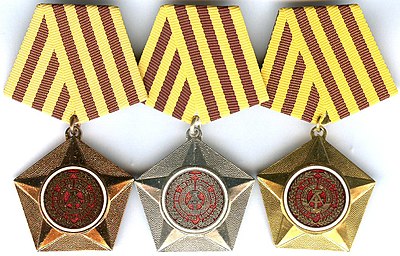Fighting demands "For services to the people and fatherland"
| Fighting forces | |
|---|---|

|
|
| Order on ribbon bronze level (obverse) | |
| Founder: | Council of Ministers of the GDR |
| Foundation year: | 1966 |
| Carrying method: | left breast side |
The fight for "For services to the people and fatherland" was a state award of the German Democratic Republic . The award was given to "Outstanding achievements in increasing the combat strength and combat readiness of the National People's Army and in fulfilling its tasks in protecting the GDR's state border ".
The order was donated on February 17, 1966 in three stages: bronze , silver and gold . It was awarded to members of the National People's Army or the border troops of the GDR , or their associations, troop units, institutions or collectives, but also to persons who were not members of these institutions. The medal could be awarded several times in the individual stages.
Graduation
The foundation of the Kampforden took place in three stages. These goods:
Award
The Kampforden was awarded by the Minister for National Defense on the occasion of the Republic Day (October 7), the anniversary of the National People's Army (March 1), the GDR Border Troops Day (December 1) or immediately after the services were completed. The Kampforden was awarded a certificate and (except for associations, troop units or institutions) a financial contribution.
In the official wording: For special merits
- "In the socialist military education of the youth,"
- "In the field of troop leadership,"
- "In education and training,"
- "In personal commitment,"
- "In the maintenance and repair of technical equipment and armament and in the development of military technology,"
- "In the development of military science,"
- "In operations that are of great benefit to the development and protection of socialism in the GDR,"
- "About the consolidation of the brotherhood in arms with the socialist brother armies" .
Design and way of carrying
The order has the shape of a pentagonal hammered plate on which a five-pointed star of the same size is stamped. In the middle is a medallion that shows the GDR's national coat of arms on a red enamelled background with the inscription "For the protection of workers and peasants" and around the inscription on the right and left a semicircular, curved branch of laurel. The medallion is closed by a narrow white enamelled ring 22 mm in diameter. The order is made of gold-plated silver, silver or bronze or, since 1973, made of gold-plated, silver-plated or bronze-colored hard metal. It has a maximum width of 40 mm. Its back is smooth or, since 1973, raised grained. It is worn on a large pentagonal clasp, which is covered with gold and wine-red striped, 24.5 mm wide ribbon. The four gold and three wine-red stripes are each 3.5 mm wide. (The rectangular interim clasp is covered with the same ribbon. Two 22 mm long crossed metal daggers in the colors of the order level are placed on top of it.) The order was worn on the upper left side of the chest.
Overview of the value of the orders of the GDR (excerpt)
- 1st place: Karl Marx Order
- 2nd place: Hero of the GDR
- 3rd place: hero of work
- 4th place: Star of Friendship of Nations
- 5th place: Patriotic Order of Merit
- 6th place: banner of labor
- 7th place: Scharnhorst Order
- 8th place: Kampforden "For services to people and fatherland"
- 9th place: Blücher Order (not awarded)
- 10th place: Military Order of Merit of the German Democratic Republic
Medal bearer
- 1968: Arno von Lenski
- 1969: Hans Rudolf Gestewitz
- 1969: Paul Laufer
- 1970: Werner Krolikowski
- 1973: Gerhard Stauch
- 1975: Gerhard Tautenhahn
- 1975: Gisela Glende
- 1975: Otto Prokop
- 1975: Siegfried Lorenz
- 1975: Peter Makowicka ( posthumously , for his efforts not to let his MiG-21 crash uncontrollably over Cottbus after an engine failure )
- 1977: Heinrich Heitsch
- 1980: Hubert Ziesche
- 1981: Hans-Ludwig Ewert
- 1982: IM Bob
- 1982: Helmut Sieger
- 1982: Alexander Schalck-Golodkowski (for: "High personal influence and support in solving important military-economic tasks.")
- 1984: Walter Halbritter
- 1986: Johannes Reuter
Excellent as a military educational institution
See also
literature
- Frank Bartel: Awards of the German Democratic Republic from the beginning to the present. Recordings by Jürgen Karpinski. Military publishing house of the German Democratic Republic, Berlin 1979.
- Günter Tautz: Orders and Medals. State awards of the German Democratic Republic. 2nd, improved and supplemented edition. Bibliographical Institute, Leipzig 1983.
Individual evidence
- ↑ Markus Wehner: For services to people and fatherland. In: FAZ.net . October 28, 2012, accessed October 13, 2018 .
- ↑ Schalck Committee. A little Bond . In: Der Spiegel . No. 24 , 1991 ( online ).
